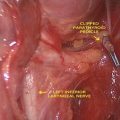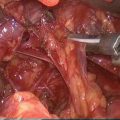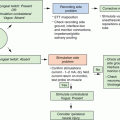Fig. 19.1
Superior pole dissection using harmonic scalpel during mini-invasive video-assisted thyroidectomy. EBSLN external branch of superior laryngeal nerve
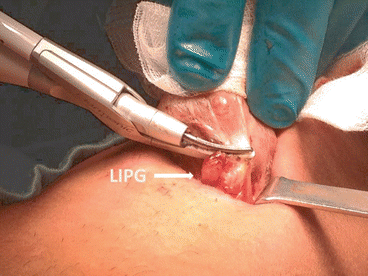
Fig. 19.2
Inferior pole dissection using Harmonic Focus® during mini-invasive thyroidectomy. LIPG left inferior parathyroid gland
Many published, comparative and observational, studies have variably reported some significant advantages in terms of operative time [16, 23–25], complications rate [26, 27], and reductions in incision size [25, 27–29] with the use of HS (ultracision or focus) respect to the conventional techniques, as clamp-and-tie in thyroid surgery [30].
In our previous study, in 2008, besides confirming that HS utilization during total thyroidectomy allows for a significant reduction in operative time (about 30 %) when compared with the conventional CT technique, we extensively analyzed the influence of this element on costs; the authors assert that, since time spent in the operating room is expensive [31], this would counterbalance the cost of the HS hand piece and eventually result in a overall cost saving. The significantly higher cost of disposable materials in the HS group was counterbalanced by significant higher costs of drugs, personnel and operative room charges in the CT group related to the longer operative time, and operative room utilization time. Nonetheless, the shorter operative time implies the possibility to treat more patients in the same operative sessions. One could anticipate that with the utilization of the HS, surgeons could perform one conventional total thryoidectomy more every three or four procedures. This could mean at least one operation more for each operative session. Ultimately, this could result in a better utilization of health resources and, above all, in a potential significant reduction of the waiting list, which, at least in our health system, has a crucial role. Another potential additional advantage of the use of HS and consequent avoidance of manual tying could be the possible reduction of human resources in the operating room. In other words, surgeons could theoretically accomplish thyroidectomy without any assistant [30].
In 2010, Miccoli et al. conducted a randomized controlled trial about the utilization of Harmonic FOCUS compared to standard CT technique in thyroid surgery. They found a significant reduction of operative time in the FOCUS group (33.4 vs. 47.2 min). They assert that the significant reduction rate of operative time occurred because the FOCUS shears allow not only coagulation and cutting the vessels but also the dissection of planes without requiring any further tools; furthermore, the very low occurrence of failures in the hemostatic division of vessels (both veins and arterials) avoids the use of manual ligatures or clips, which is time consuming. One of the most important advantages of this instrument is the very rare occurrence of delayed bleeding [32]. In this study, a significant difference in the drainage output between the two groups in favor of the FOCUS group was observed. Postoperative pain was significantly lower after 12 h and also after 24 h. The explanation for such a significant difference might be found in the shorter operative time, the reduction of neck hyperextension due to the easier access to the upper pedicle [32], and consequent reduced stretching of the wound. Others also note that edema of the tissues is reduced because of the much lower temperature reached by the Harmonic shear [22, 33].
In 2008, Cirocchi et al. conducted a systematic review and meta-analysis to compare the surgical effectiveness of HS vs. CT in total thyroidectomy in patients with thyroid benign and/or malignant pathologies. They observed that the main significant advantages of HS are shorter operative duration, lower intraoperative blood loss, and lower overall drainage volume.
In this analysis, the reduction of operative time has the advantage to reduce significantly the costs of utilization of operating room. The cut and coagulation functions permit also to reduce lymphorrea depending on ligations and sections and the authors deduce that this leads to the opportunity of anticipated discharge and subsequent reduction of costs of permanence in the hospital.
The incidence of postoperative complications is similar in two groups (transient laryngeal nerve palsy, permanent laryngeal nerve palsy, transient hypocalcemia, permanent hypocalcemia) [34].
A meta-analysis conducted in 2010 by Ecker et al. confirmed the impact of the HS on operating time, with a reduction of nearly 25 % when compared with all other hemostatic methods. With regard to postoperative pain, the data show that patients in the harmonic scalpel group had a significantly less painful postoperative course when compared with patients with suture/clip ligation plus electrocoagulation [35].
Also Melck et al., in a meta-analysis realized in 2010, showed that the utilization of the HS for total and subtotal thyroidectomy significantly reduced operative time compared to CT by greater than 23 min. Furthermore, there was a 31 % decreased risk of transient postoperative hypocalcemia with HS utilization and there was also no statistically significant difference in the risk of transient postoperative nerve damage between the two groups. Authors speculate that use of the HS may facilitate dissection of the parathyroid glands in a plane farther away from the parathyroid gland capsule, thus reducing the chance of damaging their blood supply, directly or indirectly, with either mechanical forces or electrical currents [36].
19.3 LigaSure
The LigaSure vessel sealing system (Valleylab, Boulder, Colorado) is a hemostatic device primarily designed for abdominal operations. A bipolar, electrosurgical device, it seals vessels as large as 7 mm in diameter by denaturing collagen and elastin within the vessel walls and the surrounding connective tissue. When compared with unipolar cautery, LigaSure has a reduced energy spread profile (<2 mm) and a potentially decreased risk of injury to adjacent structures [37, 38].
The device is used in abdominal surgery and has proved suitable for use in thyroid surgery [39]. LigaSure, allowing vessel sealing and division with no dispersion of the electric power and with little or no heat production, has been widely used in diverse fields of surgery for its efficiency and safety. However, in thyroid surgery, where a considerable amount of minute vessels must be divided and hence microsurgical techniques required, LigaSure is also preferred for its further efficiency by shortening the duration of the operation (Fig. 19.3) [1].
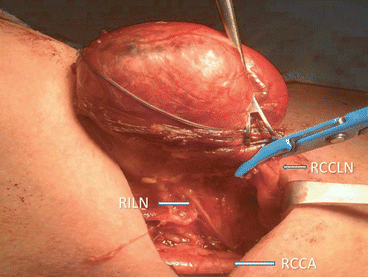

Fig. 19.3
Central neck dissection using LigaSure Precise®. RCCA right common carotid artery, RCCLN right central compartment lymph nodes, RILN right inferior laryngeal nerve
A characteristic specific to the LigaSure is the possibility to modulate the quantity of energy by applying appropriate pressure to the grip [40, 41].
Some surgeons found the earlier LigaSure precise instrument to be time consuming (in comparison with the harmonic scalpel), especially because of the absence of an integrated cutting mechanism and the lack of dissection capabilities. In this context, the LigaSure LF1212 was introduced in 2010 as an innovative technical advance for open thyroid surgery. This device is also capable of cutting with an integrated mechanism, and it is suitable for both blunt dissection and grasping and dividing tissue [42].
As for HS, several studies analyzed the use of LigaSure in thyroid surgery in comparison with CT technique and quantified the advantages in terms of operative time, reduction of perioperative complications, and decrease in hospital stay.
In 2006, Franko et al., in their clinical trial, confirmed that operative time was significantly decreased by an average of 20 min through the use of LigaSure in thyroid surgery, but this procedure did not result in any increase or decrease in the incidence of clinically apparent RLN injury, bleeding necessitating reoperation, or postoperative hypocalcemia, whether transient or permanent [43].
In 2009, Yao et al. analyzed the results of thyroid surgery performed with LigaSure compared to the conventional operation and they found that LigaSure thyroidectomy took significantly less time to complete (mean, −11.97 min). They associated the reduced operative duration with LigaSure to better intraoperative hemostatic control and not needing to ligate the vessels.
The authors noticed no significant difference in the rates of overall and individual postoperative complications (transient and permanent hypocalcemia, transient and permanent nerve lesions, hematomas, wound infections) for patients undergoing conventional vs. LigaSure thyroidectomy. Moreover, because it is used solely during the entire procedure for vascular ligation of all thyroid vessels, no suture ligations are necessary, no foreign bodies (i.e., ligations or clips) are left behind; therefore, the risk of knot slipping and clip dislodgment is nearly eliminated.
Furthermore, the clarification that, after LigaSure thyroidectomy, the postoperative pain treatment and analgesic requirements were significantly reduced, and patients returned pain-free to normal work or social activity significantly earlier is remarked by different studies [38, 44].
A further study, conducted by Ignatjovic et al. in 2011, concludes that the effects of the LigaSure procedure are equivalent to the ligation technique [45], while the maximum temperatures, energy dissipation, and collateral damage are markedly less in comparison with other nonligature hemostasis methods [46, 47]. In addition, the blood pressure necessary to break the site of blood vessel sealing is four times higher than the maximum possible arterial pressure (850–900 mmHg), and more than twofold higher than the maximum venous pressure (200–250 mmHg) [48–50]. In this study, intraoperative blood loss is lower in LigaSure group and the duration of surgery is shorter, the economic effects was generally concluded to be irrelevant as compared to the total price of the surgery [51].
19.4 BiClamp
Bipolar thermofusion BiClamp 150 (ERBE Elektromedizin GmbH, Teubingen, Germany, www.erbe-med.com) is a tool specifically designed for thyroid surgery. It works on the principle of bipolar thermofusion of tissue. Low-voltage energy is strong enough to seal vessels of up to 7 mm in diameter on the basis of collagen fiber fusion [48]. The hand piece is shaped like forceps and is easily used to grasp and coagulate the vessel. It is useful for tissue preparation as well. After placing the hand piece into the proper position on the vessel and pushing the pedal, electrocoagulation starts. The process ends with acoustic signals from the processing unit, after the vessel is sealed and it is possible to cut it. An automatic stop function prevents heat injury from the surrounding tissues. Another advantage of the instrument is the possibility of resterilization. It should not be used in the area of the RLN due to the potential risk of injuring the nerve from the dispersion of heat. The tool is not suitable for coagulation of very small vessels because forceps tips of BiClamp are thicker than conventional bipolar coagulation tips. Encrusted coagulations could adhere to the forceps tips and there is danger of damaging the vessel when the forceps are withdrawn [52].
Some studies were conducted to prove the effectiveness of this device in thyroidectomy compared to other hemostatic techniques.
Pniak et al., in a review of 2014, assert that the bipolar thermofusion BiClamp is an effective and safe method for vessels sealing during thyroidectomy, including sealing of the main thyroid vessels. They demonstrated that BiClamp may achieve statistically significant reductions in the frequency of postoperative bleeding compared with conventional vessel ligature and it also leads to significant reductions in operative time [52].
19.5 Comparison Between Devices
Most studies comparing the LigaSure to HS have been performed on patients undergoing abdominal surgeries, such as hysterectomies, laparoscopic splenectomies, and laparoscopic colectomies [53, 54]. Studies have compared conventional knot tying to the LigaSure device or harmonic scalpel in total thyroidectomy, but few have done a comparison of both devices [24, 28, 55–59].
One of these studies was conducted in 2011 by Zarebczan et al. and it showed no difference in the rate of transient hoarseness, permanent recurrent laryngeal nerve injury, transient hypocalcemia, and hematoma formation between the two devices when used in total thyroidectomy. When comparing the two devices to one another, researchers found a significant decrease in operative time when the harmonic scalpel was used, with an average decrease in operative time of 15 min and similar findings in operative time were shown for patients who underwent thyroid lobectomy: cases in which the LigaSure was used took 7 min longer on average. They also illustrated a decrease in length of hospital stay for patients who underwent total thyroidectomy with the harmonic scalpel [60].
In 2008, Sartori et al. conducted a comparison study, in which they analyzed three groups of patients, who underwent thyroidectomy using CT, HS, or LigaSure. They showed that there was a significant difference in overall morbidity between patients in the CT group and the other two; HS and LigaSure groups had a higher complication rate but there was no difference between LigaSure and HS patients; in particular, there was a statistically significant difference in postoperative hypocalcemia rate between patients operated with conventional technique and those in the new technologies groups. When comparing LigaSure and HS patients, postoperative calcemia did not significantly differ, but patients in the HS group had a higher relative risk of postoperative hypoparathyroidism (RR = 3.75).
However, this had no impact on patient outcome since hypocalcemia was always transient and asymptomatic in more than two thirds of the patients and the length of hospital stay was not affected. Recurrent laryngeal nerve palsies, instead, were the same in the three groups.
HS patients had a mean operating time shortening of 24 min when compared to CT patients, while no advantage was noticed regarding operating time when using LigaSure. Intraoperative blood losses were similar among groups [61].
Oussoultzoglou et al., in a prospective study conducted in 2008, conclude that HS is associated with reduced postoperative hypocalcemia, reduced postoperative oral calcium supplementation requirement, and reduces operative time compared with the LigaSure device [62].
Dionigi et al., in their article written in 2011, assert that the only justified comparison is between the new LigaSure™ LF1212, which has an integrated cutting capability, and the FOCUS. In their study, they found no significant differences in the operative time between the two groups (LigaSure and FOCUS). The rate of nerve lesions, bleeding, drainage, and postoperative calcium concentration were the same for the two devices, with no significant differences. The use of FOCUS significantly increased the incidence of hypoparathyroidism; their working hypothesis was that the parathyroid glands are more likely to be injured because of the potential for greater thermal spread when using the Harmonic FOCUS. However, the postoperative calcium levels were not significantly different between the two groups. The only significant finding within this context was a significantly reduced early postoperative PTH value, which potentially indicates a need for supplementation, in the FOCUS group. At 24 h after surgery, the calcium levels were no longer different, but calcium supplementation was still significantly higher in the FOCUS group.
The authors affirm that thermal injury to the parathyroids is avoidable by having a larger distance of the energy-based dissecting tools from these vital anatomical structures (>3 mm), or with a sequential use and water-cool of the instruments [63, 64].
The authors noticed, also, a lower rate of pain experienced while swallowing in the LigaSure group, but overall patients’ low analgesic requirement and extra doses of analgesics were the same; they explained this with the hypothesis that LigaSure delivers less energy because of the presence of active feedback control over the power output, limiting thermal spread to adjacent tissues. Furthermore, in this study it is noticed that the LigaSure LF1212 allowed the surgeon to dissect, coagulate and cut vessels in significantly narrower spaces than did the FOCUS. A possible explanation for this is given considering the longer tips of the LF1212 and the consequent reduced stretching of the wound [42].
Rahbari et al. realized a study, in 2011, that showed no significant difference in the operative cost or operative time in thyroidectomies performed with HS or with LigaSure. There was also no significant difference in complication rates between the two groups, and in the cost and the number of pain medications used as a surrogate measure of pain associated with the thyroidectomy [65].
More recently, in 2013, Contin et al., in a meta-analysis, demonstrated that using energized vessel sealing systems (LigaSure) can significantly reduce operation time. Additionally, the use of HS was associated with several small-scale benefits, that is, reduced intra- and postoperative blood loss, reduced rates of transient hypocalcemia and postoperative pain as well as a reduced duration of hospital stay. While these improvements were marginal and not observed for the use of LigaSure, the conventional technique was not superior in any outcome investigated. In particular, the clinically important safety outcomes of recurrent nerve palsy and rates of clinically symptomatic hypocalcemia were not negatively affected by using any of the energized vessel systems. Nevertheless, the detected differences between the devices could be due to the different spectrum of use the devices offer. While the LigaSure offers more time-consuming multiple-sealing approaches at the same vessel, the HS divides the tissue at the same time of coagulation.
Stay updated, free articles. Join our Telegram channel

Full access? Get Clinical Tree



